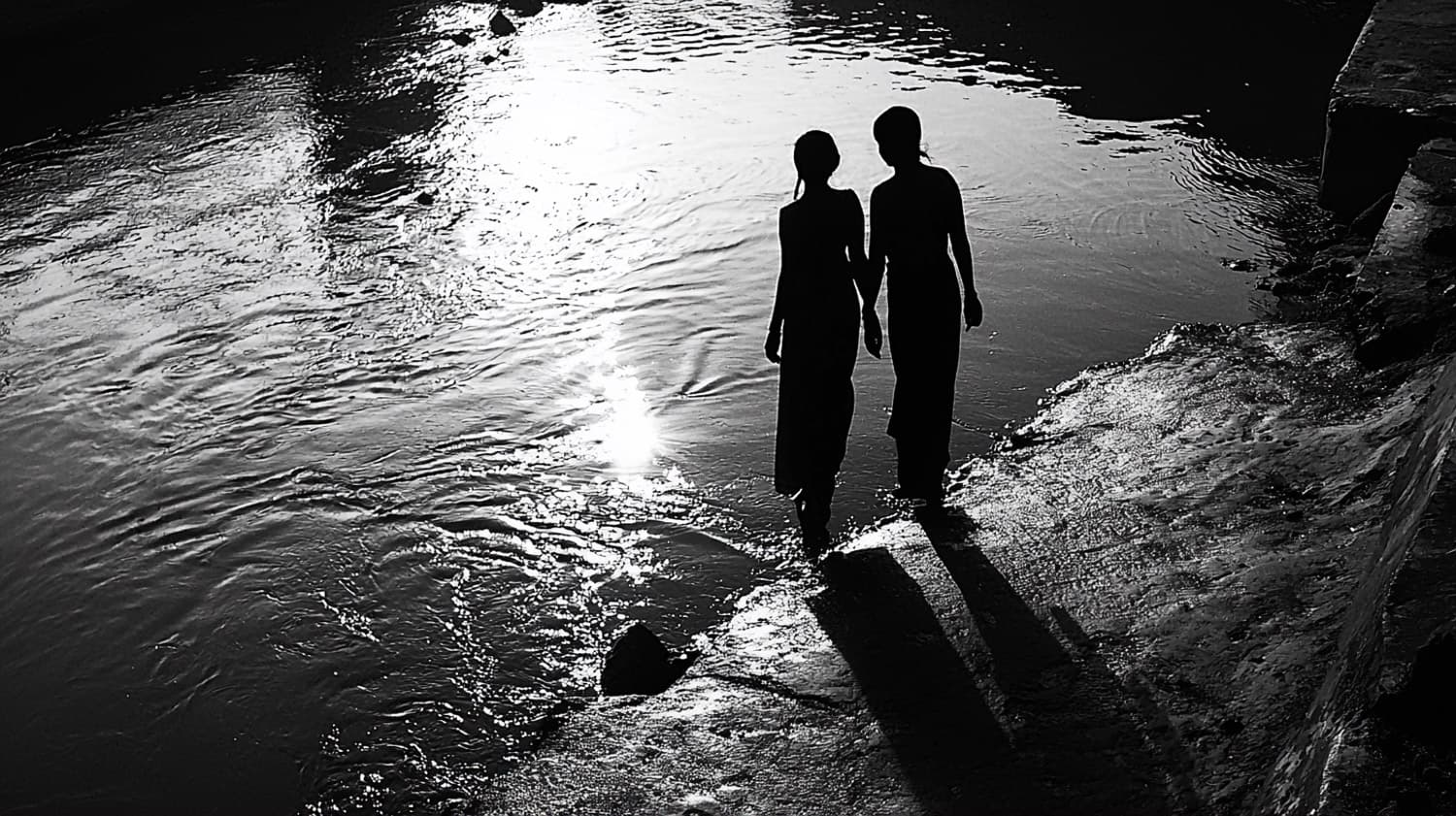Dayanita Singh, born in 1961 in New Delhi, has emerged as a pioneering figure in contemporary Indian photography. Her innovative approach to visual storytelling has redefined the boundaries of traditional photography, pushing the medium into new and exciting territories.
Singh's work transcends the two-dimensional constraints of conventional photography, offering viewers novel ways to experience and engage with images.
Her artistic journey began unexpectedly, as she initially had no intentions of pursuing photography professionally. This serendipitous entry into the field has contributed to her unique perspective and unconventional methods.
One of Singh's most distinctive contributions to the art world is her experimental approach to photobook creation.
She has consistently challenged the standard formats of displaying and disseminating photographs, often incorporating portable museum formats and reusing images across decades.
This iterative process has allowed her to develop a practice that is fundamentally archival in nature, preserving and recontextualizing moments across time.
Key Takeaways
- Singh's work redefines traditional photography by exploring innovative presentation formats.
- Her artistic practice emphasizes the archival nature of photography through image reuse and recontextualization.
- Singh's unconventional entry into photography has shaped her unique perspective and storytelling approach.
The Life and Career of Dayanita Singh
Dayanita Singh has emerged as a pivotal figure in contemporary Indian photography. Her innovative approach to visual storytelling and unique presentation formats have garnered international acclaim.
Early Influences and Education
Born in New Delhi in 1961, Dayanita Singh grew up surrounded by creativity. Her mother's work as a graphic designer sparked her early interest in visual arts.
Singh's formal education began at the National Institute of Design in Ahmedabad, where she studied visual communication.
During her time at the institute, Singh discovered her passion for photography. This led her to pursue further studies at the International Center of Photography in New York, honing her technical skills and artistic vision.
Major Photographic Works and Exhibitions
Singh's career took off in the 1980s when she documented classical musicians on tour. This experience shaped her unique perspective on capturing intimate moments and storytelling through images.
Her notable works include:
- "Myself Mona Ahmed" (2001)
- "Go Away Closer" (2007)
- "File Room" (2013)
Singh's innovative "mobile museums" concept allows for flexible presentation of her photographs, challenging traditional exhibition formats.
Her work has been showcased in prestigious venues worldwide, including the Museum of Modern Art in New York and the Tate Modern in London.
Collaborations and Contributions to the Art World
Singh's impact extends beyond her individual work. She has collaborated with writers, architects, and musicians, pushing the boundaries of interdisciplinary art.
Her partnership with author Aveek Sen resulted in the critically acclaimed book "House of Love" (2011).
As a mentor, Singh has influenced a new generation of photographers. She regularly conducts workshops and lectures, sharing her unique approach to visual storytelling.
Singh's contributions to contemporary art have been recognized with numerous awards, including the 2022 Hasselblad Award in Photography.
Themes and Styles in Singh's Photography
Dayanita Singh's photography explores intimate spaces, fleeting moments, and complex identities. Her work challenges traditional photographic conventions through innovative presentation formats and subject matter.
Intimacy and Interiority
Singh's photographs often capture private spaces and personal relationships. She focuses on interiors, both physical and emotional, revealing the hidden corners of homes and minds.
Her images of domestic scenes and quiet moments convey a sense of closeness and vulnerability. Singh's subjects are frequently family members, friends, and acquaintances, allowing her to portray intimate connections.
The photographer's use of soft lighting and careful composition emphasizes the mood and atmosphere of these private worlds. Through her lens, everyday objects and spaces take on deeper significance, hinting at the lives and stories they contain.
Documenting the Ephemeral
Singh's work often captures fleeting moments and transient experiences. She has a keen eye for the temporary and the changeable, preserving glimpses of people, places, and events that might otherwise be lost to time.
Her photographs of archives and file rooms highlight the fragility of physical records and memories. These images serve as a meditation on the passage of time and the impermanence of human endeavors.
Singh also documents cultural and social changes in India, capturing traditions and ways of life that are slowly disappearing. Her work acts as a visual record of these shifting realities.
Exploration of Identity and Gender
Singh's photography delves into complex questions of identity and gender in contemporary Indian society. Her images challenge traditional notions of femininity and masculinity, offering nuanced portrayals of diverse individuals.
The photographer often focuses on women's experiences, depicting their struggles, triumphs, and everyday lives. She explores the ways in which gender roles are evolving in India, capturing both progress and persisting inequalities.
Singh's work also touches on themes of sexuality and non-conformity. Her photographs of queer and transgender individuals provide visibility to marginalized communities and challenge societal norms.
Innovation in Photobook Creation
Dayanita Singh revolutionized the photobook medium through unconventional structures and thoughtful integration of visual and textual elements. Her pioneering approaches transformed books into dynamic, interactive art objects.
Narrative Structure and Book Design
Singh's photobooks defy traditional linear narratives. She experiments with portable museum formats, creating accordion-style books that can be displayed as exhibitions. This allows readers to engage with images in multiple configurations.
Her "Museum Bhavan" series features wooden structures housing thematically grouped photographs. These miniature museums blur the line between book and installation art.
Singh often reuses photographs across different publications, creating new contexts and meanings. This iterative approach allows her images to evolve and take on fresh significance over time.
Interplay of Text and Image
Singh carefully balances visual and textual elements in her books. She incorporates diverse writing styles, from poetic fragments to academic essays, enhancing the photographic narratives.
In some works, Singh uses text sparingly, allowing images to speak for themselves. Other books feature extensive written components that provide context or offer alternative interpretations.
Her collaboration with writers and poets adds layers of meaning to the visual stories. This interdisciplinary approach creates rich, multifaceted reading experiences that challenge traditional photobook conventions.
Influence and Legacy
Dayanita Singh's innovative approach to photography has left an indelible mark on the Indian art scene. Her work challenges traditional boundaries and inspires a new generation of visual storytellers.
Impacts on Contemporary Indian Photography
Singh's unique style has reshaped the landscape of contemporary Indian photography. Her conceptual approach to image-making encourages photographers to explore beyond conventional documentary formats.
Singh's book-objects and mobile museums have introduced new ways of presenting and experiencing photography. This has inspired many artists to experiment with alternative exhibition formats.
Her focus on personal narratives and everyday moments has influenced photographers to look inward and explore intimate themes. This shift has led to a more diverse range of subjects in Indian photography.
Singh's work has also brought attention to lesser-known aspects of Indian society, encouraging others to document overlooked communities and spaces.
Recognition and Awards
Singh's contributions to photography have earned her numerous accolades. She received the prestigious Hasselblad Award in 2022, recognizing her significant impact on the medium.
Her work has been exhibited in major museums worldwide, including the Museum of Modern Art in New York and the Tate Modern in London. These exhibitions have brought Indian contemporary photography to global audiences.
Singh's books have won critical acclaim, with "Museum Bhavan" receiving the Paris Photo-Aperture Foundation PhotoBook of the Year Award in 2017. This recognition has elevated the status of photobooks in India.
Her innovative approaches have also led to her appointment as a juror for several international photography competitions, further extending her influence in the field.
Frequently Asked Questions
Dayanita Singh's unique approach to photography has sparked curiosity and admiration in the art world. Her innovative techniques and thought-provoking themes have reshaped contemporary Indian photography.
How has Dayanita Singh influenced contemporary Indian photography?
Dayanita Singh has revolutionized the way photographs are presented and consumed. She pioneered the concept of book-objects and mobile museums, challenging traditional exhibition formats.
Her work has inspired a new generation of photographers to explore unconventional storytelling methods. Singh's focus on everyday life and personal narratives has encouraged others to look beyond exotic representations of India.
What are the distinguishing features of Dayanita Singh's photographic work?
Singh's photography is characterized by its intimate and contemplative nature. She often works in black and white, creating atmospheric images that evoke a sense of memory and passage of time.
Her innovative presentation methods, such as accordion-fold books and modular wooden structures, set her work apart. These formats allow viewers to interact with and reconfigure her images, creating new narratives.
What themes are commonly explored in Dayanita Singh's photography?
Singh frequently explores themes of identity, family, and social structures in India. Her work often focuses on individuals frequently depicted throughout her oeuvre, including transgender people, her mother, and friends.
She also examines the concept of absence and presence. She captures empty spaces and objects that suggest human habitation. Archives and the preservation of memory are recurring themes in her photographs.
Can you explain the concept of visual storytelling as applied in Dayanita Singh's photographs?
Singh's visual storytelling goes beyond single images to create complex narratives. She often presents her photographs in sequences or grids, allowing viewers to make connections and construct their own stories.
Her book-objects and mobile museums enable multiple readings of the same images. This approach encourages viewers to actively engage with the photographs, blurring the line between creator and audience.
What is the significance of the Dayanita Singh Museum of Photography in her career?
The Dayanita Singh Museum of Photography is not a physical space but a conceptual project. It represents Singh's innovative approach to displaying and disseminating her work.
This "museum" consists of portable wooden structures that can be arranged in various configurations. It allows Singh to bring her exhibitions to diverse locations, democratizing access to her art.
Which exhibitions or collections are essential to understanding Dayanita Singh's contributions to photography?
Singh's "Museum Bhavan" series is crucial to understanding her innovative approach. This project has been exhibited at major institutions worldwide.
Her book "File Room" (2013) explores the theme of archives and bureaucracy in India. The "Go Away Closer" exhibition at the Hayward Gallery in London (2013) was a significant retrospective of her work.





















